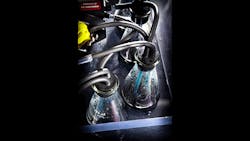New Flow Battery Could Back-Up Local Grids, Power Cars and Trains
A new zinc-polyiodide redox flow battery developed at the Pacific Northwest National Laboratory (PNNL) has nearly the energy density of lithium-ion batteries, and is inherently fire safe. With further development, this small, energy-dense battery could be used to strengthen and back-up local power grids. It might also power cars and trucks, as well as trains.
Like other flow batteries, the zinc-polyiodide version generates power by pumping a pair of liquid electrolytes from individual tanks into separate sections inside a common container. The two liquids the research team used as electrolytes in a demonstration battery were zinc-polyiodide and zinc-iodide. A semipermeable membrane separates the sections but permits zinc ions to pass through to the negative (anode side) and create electricity through chemical reactions.
The demonstration battery put out more energy than today’s most commonly used flow batteries: the zinc-bromide and vanadium batteries. It also put out nearly 70% of the power of a lithium-ion battery.
For comparison, the new battery discharged 167 watt-hours per liter of electrolyte. A zinc bromide discharges 70 watt-hours per liter, and a vanadium flow battery creates about 20 watt-hours per liter. The new battery could also be improved, pushing its output to 322 watt-hours per liter, by adding more chemicals to make the electrolyte solutions stronger.
PNNL’s battery has several advantages over other flow batteries. It is safer for people and the environment because it does not use acidic electrolytes. The water-based liquids it does use make the battery almost impossible to set on fire, unlike lithium-ion batteries that can overheat and ignite. The electrolytes are not corrosive, so there’s no need for expensive materials to contain or pump them.
The new battery also works in temperatures ranging from -4°F to 122°F, a much wider climactic range than other battery chemistries which require heating or cooling systems to operate. Such additional components cut into a battery’s net power production.
The team ran into one problem—a build-up of metallic zinc that grew from the battery’s negative electrode and went through the membrane. The metallic zinc contamination made the battery less efficient. Researchers reduced the buildup, called zinc dendrite, by adding alcohol to the electrolyte solution.
Managing the problem of zinc dendrite formation will be one key to making zinc-polyiodide batteries usable in the real world. Researchers will continue to experiment with different alcohols and other additives, as well as use advanced instruments to characterize how the battery's materials respond to them. Some of the advanced tools they use to characterize the new battery's chemical interactions include nuclear magnetic resonance, Raman spectroscopy, mass spectroscopy, and more. The team will also build a larger, 100-watt-hour model of the battery for additional testing.
This research program was funded by the Department of Energy's Office of Electricity Delivery and Energy Reliability.
